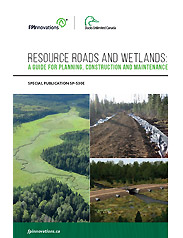Corduroy is back in fashion with foresters and conservationists who want new ways to conserve wetlands crossed by resource roads. The earliest days of Canada’s timber trade featured wetland crossings made of logs lined up in rows, which resembled corduroy fabric. Road building gradually became more permanent, sometimes affecting water flow in wetlands.
 Putting a modern spin on corduroy roads is one of the recommendations in a new field guide just released by FPInnovations and Ducks Unlimited Canada. The guide, “Resource Roads and Wetlands: A Guide for Planning, Construction and Maintenance,” developed in part with funding from the SFI Conservation and Community Partnerships Grant program, offers best management practices to mitigate the impacts of roads on wetlands in Canada’s forests.
Putting a modern spin on corduroy roads is one of the recommendations in a new field guide just released by FPInnovations and Ducks Unlimited Canada. The guide, “Resource Roads and Wetlands: A Guide for Planning, Construction and Maintenance,” developed in part with funding from the SFI Conservation and Community Partnerships Grant program, offers best management practices to mitigate the impacts of roads on wetlands in Canada’s forests.
The new field guide’s road-building best practices are predicated on understanding the nature of individual wetlands. “These are delicate ecosystems with different characteristics. For example, water in bogs is stagnant; in swamps it fluctuates; and in fens it’s a slow trickle. Understanding the way water flows is key to choosing the right road construction,” said Greg Siekaniec, CEO of Ducks Unlimited Canada.
Scientists, biologists, wetland ecologists, engineers and GIS specialists at FPInnovations and Ducks Unlimited shared their expertise to plan and build roads in ways that conserve Canada’s critical boreal forest wetland ecosystems.
“FPInnovations and our partners are committed to working together to support and promote best practices in the planning, construction and maintenance of resource roads in wetlands,” said Pierre Lapointe, FPInnovations President and CEO. “We are proud of this collaboration which demonstrates the forest sector’s continued leadership in reducing its environmental footprint and adapting to climate change. By working together we can better develop and promote best practices that maintain the health of wetlands while supporting communities dependent on sustainable resource-based industries.”
read more/source: http://www.sfiprogram.org/media-resources/news/new-national-field-guide-helps-wetlands-and-forest-roads-coexist-using-a-modern-spin-on-old-methods/
